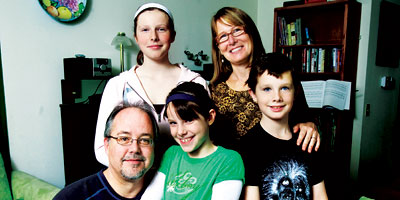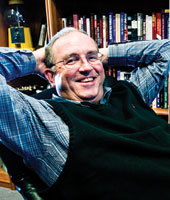When Families Falter
The difficult work of reconciling our closest relationships

The Presars have a sand-filled vase representing five individuals coming together as a family.
By Hope McPherson [hmcpherson@spu.edu]
Photos by Mike Siegel, courtesy of the Presar Family, and courtesy of Veer
We don’t need to look much further than newspaper advice columnists for proof that people need and desire healing in their relationships. Just read the thousands of letters that pour in to “Dear Abby,” “Ask Amy,” and the like.
In fact, forget the columnists. We don’t need to look beyond our own relationships with family members to encounter the longing for reconciliation.
No family is exempt from pain and disappointment. A spouse is emotionally distant; a sibling struggles with alcoholism; a parent and child disagree over lifestyle choices. Everything from inattention and unkindness to infidelity and addiction can damage our closest interpersonal connections.
So what does reconciliation mean when it comes to families? Simply getting along? Not "making waves"? Unconditional acceptance? Or does it mean something else?
“From a family therapist’s perspective, reconciliation is staying in relationship while honoring differences and establishing appropriate boundaries,” says Claudia Grauf-Grounds, professor of marriage and family therapy at Seattle Pacific University. “It’s learning to balance connection and separateness. And there’s always tension in that.”
Adds SPU Professor of Psychology Les Parrott, “Reconciliation, in the simplest terms, is the re-joining of two people after a rift of any kind has occurred. It’s the difficult work of re-establishing a healthy relationship.”
Overcoming a Family’s Pain
Jeff McFarlane, who earned his doctorate in clinical psychology from Seattle Pacific in 2001, has experienced family rupture and reconciliation on a grand scale. The youngest of four children, one of whom died in childhood, McFarlane was raised by alcoholic parents. While in elementary school, he plotted to kill his abusive father by breaking some of the omnipresent empty liquor bottles and spreading glass at the bottom of a set of stairs his father frequently fell down.
As the McFarlane children grew up in the volatile home,
Jeff’s sister became a prostitute, and his brother became a heroin addict. McFarlane guarded the family secrets, never letting his friends know what happened within the walls of his house.
Then one day, while renewing his car license tabs, Jeff’s brother met a woman who told him about Jesus. “She presented the gospel to him, and he accepted Christ right there,” McFarlane says, adding that his brother, an extreme extrovert, in turn shared the gospel with him. “He shared everything. If he was doing heroin, he wanted you to do it, because it was the best thing going.”
But before long, 21-year-old McFarlane was seeing a lasting change in his brother. A year later, McFarlane chose to become a Christian, too. Eventually, so did his sister.
Time passed, and McFarlane felt God prompting him to forgive and then reconcile with his father. What followed was a slow but steady reconciliation process within a family that had seemed hopelessly shattered. At the end of his life, McFarlane’s father would become a Christian as well, and apologize for the decades of mistakes that had harmed his children.

Sandra and Gerry Presar were childhood friends before they married other people.
|
What Reconciliation Looks Like
No two healthy relationships are alike. Parrott describes a good relationship simply as “the result of two healthy people who add value to each other’s lives.” But there are principles that can help family members maintain strong connections and help heal relationships when they become damaged.
Healthy families balance togetherness and separateness as life’s circumstances change, says Grauf-Grounds, who counsels couples and families in her private practice as a licensed marriage and family therapist. This means individuals in relationship may have more or less connection at certain phases of their lives, such as after a baby is born, when illness strikes, or when the physical distance between them grows. Accepting this natural ebb and flow, she says, helps to avoid unhealthy conflict or separation.
When a relationship is strained or broken, however, recon-
ciliation requires a commitment to healing — and a process of
reconnection that can be very difficult, even painful. A good starting point is empathy, says Parrott, whose new book, Trading Places, focuses on that topic. “One of the most startling and encouraging statistics I’m aware of is that 90 percent of the issues we struggle with interpersonally could be resolved if we could simply see the issue from the other person’s perspective,” he notes.
If the commitment to reconciliation is there, he says, other steps may include: “owning your own responsibility” in the schism; confession, repentance, and making amends; and forgiveness of the other person’s wrongs.
Forgiveness is essential to reconciliation, and Christians
comprehend a deeper hand in this process, says McFarlane,
who now assists other families in need of reconciliation as clinical director of Restoration Counseling Services in Shoreline, Washington. “Without Christ, I don’t think I could have gotten to a place of loving and forgiving my dad. Without Christ,
I wanted to kill him.”
There are significant human limits to the reconciliation process, agrees Grauf-Grounds. “You can only go so far by yourself,” she says. “I think forgiveness and reconciliation can happen with nonbelievers, but I think it’s the undercurrent of God’s work in their lives, even if they don’t recognize it.”
Forgiveness vs. Reconciliation
Since Jesus taught his followers to pray, “forgive us our trespasses as we forgive those who trespass against us,” Christians have strived — however imperfectly — to show forgiveness in even the most difficult circumstances. Does that mean they just need to show more forgiveness in order to heal broken relationships?
“Forgiveness doesn’t always restore a relationship,” says McFarlane. “Reconciliation takes two people, and forgiveness takes only one.”
Adds Grauf-Grounds: “We tend to think individualistically in Western culture, but we have to be in relationship to reconcile. We can’t be the Lone Ranger fixer. It’s a ‘we,’ not a ‘me’ proposition.
“You have to knock on the door and say, ‘Do you want to be in a relationship?’ And then the person can choose to walk through it or not.”
Walking Through the Door
When Marianne Gesler’s (not her real name) daughter, a Caucasian, eloped with an African-American Army officer in 1991, Gesler’s husband broke off ties to his only child. Gesler and her daughter, a 1985 SPU alumna, remained close, doing the only two things they knew how to do in the circumstances: pray and cry.
“The Lord showed me right from the beginning in Galatians 5:6 that the only way we were going to get through this was through the Word, through prayer, and by walking in love,” says Gesler.
For the next four years, father and daughter were estranged. Then, in April 1995, the Geslers’ daughter and son-in-law returned home after a deployment in Europe. Easter was coming, and Gesler informed her husband that she had invited the couple to dinner. He could leave the house if he wanted, she said, and she wouldn’t hold it against him — but they were coming for dinner.
When Gesler returned from church that Easter Sunday, her husband was still home. And when their daughter and her
husband arrived, Gesler’s husband first went to his son-in-law, his hand outstretched in greeting. Then he hugged his daughter.
“When I said grace at that Easter dinner, it was just like the ultimate blessing for us to be together,” Gesler says. The moment, she is convinced, came about because of constant prayer; showing love to her family; and a decision never to give her husband an ultimatum, but an open door.

Jeff McFarlane now counsels other families in need of reconciliation. |
When Reconciliation Can't Occur
As desirable as reconciliation is, it does not mean accepting a family member’s inappropriate or unsafe behavior, says Grauf-Grounds. “It’s possible to stay in relationship while setting boundaries,” she says. “Some people would say that means you’re not reconciled, but I’d say you are. You’re leaving the door unlocked; it’s not barricaded.”
Once McFarlane had a family of his own, he continued to strengthen ties with his father. “But I didn’t trust him,” he admits. “I wouldn’t have left my kids alone in his presence. He was not any safer than when I was 8, but there was still a gradual restoring of my relationship with him.”
Sometimes, however, reconciliation isn’t possible — either because the other family member refuses to participate or because one of the people in the relationship is incapacitated or has died.
Karen Hansen ’81 (not her real name) spent many years as the guardian for her mother, who suffered from a mental illness that required institutionalization until her death in 2002. “Much of the pain in our relationship over my lifetime may have been the result of her illness before it was even diagnosed,” says
Hansen. “But how could we ever sort that out when she was not thinking clearly?
“In her later years, we experienced something like reconciliation only in rare moments — when she was lucid enough for us to exchange a glance or word of love. And we both believed we would see each other, whole and healthy, in heaven one day.
I know people who don’t even have that much to hold onto.”
Psychologists commonly encourage clients in these situations to use techniques such as “the empty chair” method. Sitting
facing an empty chair, “you do your best to recreate a conversation between you and this person you can’t talk to in the flesh and blood,” says Parrott. “It may not be the best form of reconciliation, but it’s at least hinting at it and getting closer to it.”
What if someone just goes on living without any attempt at reconciliation? “It drains your spirit,” says Parrott. “It’s difficult to experience the lightness of life when you don’t have closure — and that closure comes through reconciliation.”
Reconciliation: The Best Hard Work
One reason people don’t do the work of reconciliation in families is precisely because it is work. It takes time, commitment, creativity, love, and faith.
Following an irreconcilable divorce, one of the most difficult tightropes thousands of people balance each day is life in a blended family. When Gerry Presar, an SPU graduate student, married in August 2006, it was the second marriage for both him and his new wife, Sandra. “One of my vows to her children was to support their relationship with their dad,” he says. That meant seeking a reconciled relationship as a family with Sandra’s ex-husband.
As time went on, Presar made good on his vow. He, his wife, and her ex-husband attended parent-teacher conferences together, and the three met to discuss the children as issues arose.
Eventually, Presar suggested that because their relationship was going well, they should open a three-way bank account to which the adults could contribute and from which they could withdraw for kid-related expenses. “Their dad has full access to it, as do we,” says Presar. “It’s working great.” Now he’s looking forward to a day when he and his wife’s ex-husband can go out and spend an evening together.
McFarlane knows that good does come out of difficult circumstances, that wounds are healed, and that human failings are transformed by God’s love and grace. Today, he and his siblings sometimes speak at men’s gatherings, sharing the story of their gradual reconciliation.
“I would describe reconciliation as hard work, but the best work in relationship,” says McFarlane. “Being reconciled in little and big things is an incredible transformation that can ultimately begin with God’s transformation of us. That’s not a bad day.”
Exclusives: Related Response Videos
Associate Professor of Marriage and Family Therapy Claudia Grauf-Grounds on ways to begin reconcilation with an estranged family member or friend.
Professor of Psychology Les Parrott describes why empathy is so important when trying to reconcile breaks in your close relationships.
Return to top
Back to Features Home
|